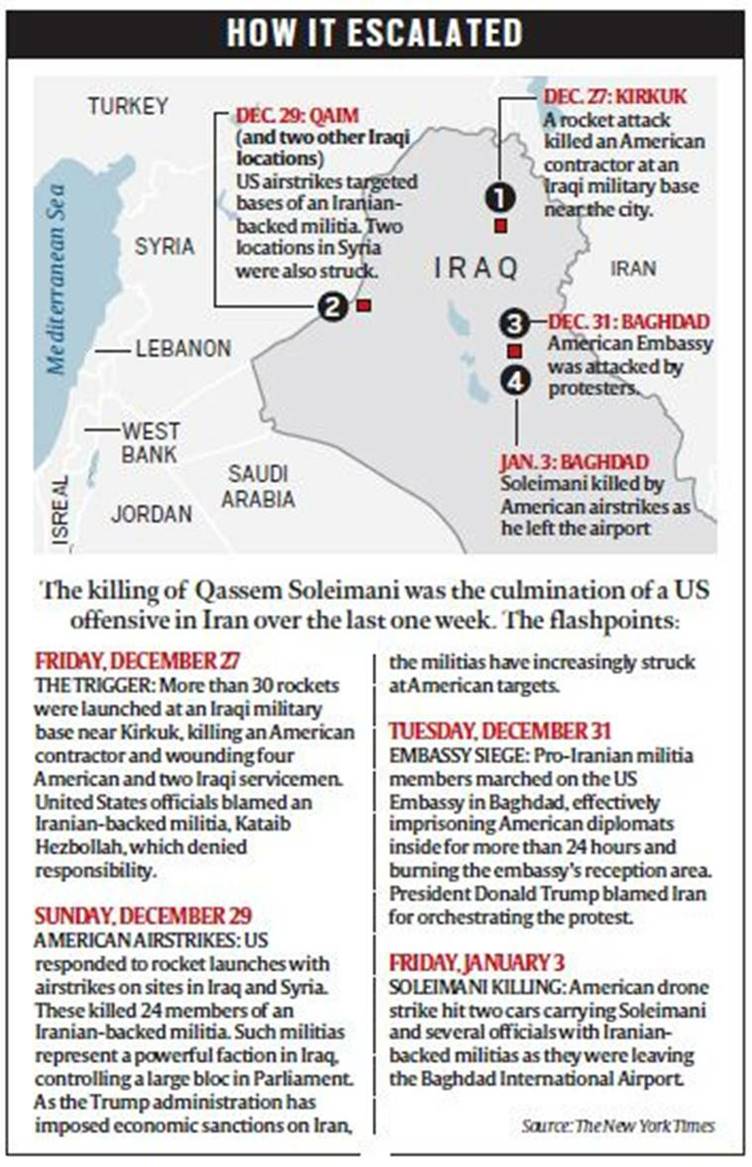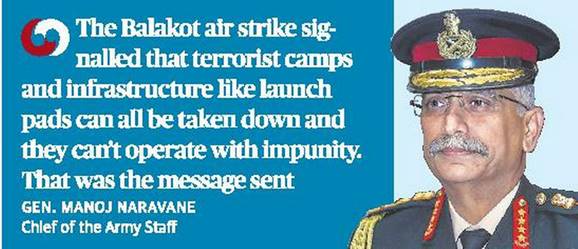



Explained: Why General Qassem Soleimani mattered
- Gen Soleimani was killed in an airstrike, for which the US later claimed responsibility.
- The blast also killed others including Abu Mahdi al-Muhandis, deputy commander of the Iranian-backed militias in Iraq known as Popular Mobilisation Forces.
- Soleimani, 62, was in charge of the Quds Force of Iran’s Islamic Revolutionary Guard Corps (IRGC), which the US designated as a Foreign Terrorist Organization in April last year.
- He looked after intelligence gathering and covert military operations.
- Drew immense influence from his closeness to Iran’s supreme leader, Ayatollah Ali Khamenei.
- He has been responsible for the creation of an arc of influence — which Iran terms its ‘Axis of Resistance’ — extending from the Gulf of Oman through Iraq, Syria, and Lebanon to the eastern shores of the Mediterranean Sea.
- Observers have equated his killing with the killing of a United States Vice President.
- He had threatened USA many times. He claimed that they have greater control in asymmetrical warfare in Middle East.
- Cooperation between USA and Soleimani ended in 2002 after President George W Bush branded Iran a nuclear proliferator, an exporter of terrorism, and part of an “Axis of Evil.
- The US was accusing Soleimani of plotting attacks on US soldiers following the 2003 invasion of Iraq, which eventually toppled Saddam Hussein.
- In 2011, the Treasury Department placed him on a sanctions blacklist.
- Soleimani was believed to be the chief strategist behind Iran’s military ventures and influence in Syria, Iraq and throughout the Middle East.
- He was assassinating rivals, arming allies, and, for most of a decade, directing a network of militant groups that killed hundreds of Americans in Iraq

- Khomeini had created the prototype in 1979, with the goal of protecting Iran and exporting the Islamic Revolution.
- In 1982, Revolutionary Guard officers were sent to Lebanon to help organise Shia militias in the civil war, which eventually led to the creation of Hezbollah.
- Quds Force has contributed roughly 125,000 men to Iran’s forces and has the capability of undertaking asymmetric warfare and covert operations.
- General Soleimani and his Quds Force were responsible for the deaths of hundreds of American and coalition service members and the wounding of thousands more.
- He had orchestrated attacks on coalition bases in Iraq over the last several months — including the attack on December 27th — culminating in the death and wounding of additional American and Iraqi personnel.
- US had designated the IRGC including the Quds Force as a Foreign Terrorist Organization.
- It uses terrorism as a key tool of statecraft and that the IRGC, part of Iran is official military.
- Its support for terrorism is foundational and institutional, and it has killed US citizens.
- The strike has left the Middle East on edge, with possible repercussions beyond the region.
- Revolutionary Guards said anti-US forces would exact revenge across the Muslim world.
- US officials were braced for Iranian retaliatory attacks, possibly including cyberattacks and terrorism, on American interests and allies.
- Israel, too, was preparing for Iranian strikes.
- The killing could have a ripple effect in any number of countries across the Middle East where Iran and the US compete for influence.
- She was born on January 3, 1831.
- She married activist and social-reformer Jyotirao Phule when she was nine years old.
- She founded India’s first school for girls called Bhide Wada in Pune in 1948.
- Her work was admirable because nationalists including Tilak opposed the setting up of schools for girls and non-Brahmins citing loss of nationality.
- She recognised that education was one of the central planks through which women and the depressed classes could become empowered and hope to stand on an equal footing with the rest of the society.
- Engaged in a passionate struggle to build a movement for equality between men and women and for social justice.
- Started the Literacy Mission in India between 1854-55.
- Started the Satyashodhak Samaj (Society for Truth-Seeking), through which they wanted to initiate the practice of Satyashodhak marriage, in which no dowry was taken.
- She is also considered to be one of the “crusaders of gender justice”.
- She was able to develop a voice and agency of her own, at a time when women were suppressed and lived a “sub-human existence”.
- She advocated values such as humanism, liberty, equality, brotherhood, rationalism and the importance of education among others.
The anti-child marriage law does not intend to punish a male aged between 18 and 21 years for marrying a female adult.
- It was interpreting Section 9 of the Prohibition of Child Marriage Act, 2006.
- It says that whoever, being a male adult above 18 years of age, contracts a child marriage shall be punishable with rigorous imprisonment, which may extend to two years or with fine, which may extend to one-lakh rupees or with both.
- Neither does the provision punish a child for marrying a woman nor a woman for marrying a male child.
- Reason behind this is, in a society like ours, decisions regarding marriage are usually taken by the family members of the bride and groom, and women generally have little say in the matter.
- The intention behind punishing only male adults contracting child marriages is to protect minor girls.
- It also gives an option for prospective grooms who are between 18 and 21 years old to opt out of marriages.
- The Prohibition Of Child Marriage Act, 2006 provides for the prohibition of solemnisation of child marriages and for matters connected therewith or incidental thereto.
- This Act replaces the Child Marriage Restraint Act, 1929 by repealing it.
- The age of marriage for boys is 21 and for girls, it is 18 and any marriage of people below this age will be considered as a child marriage, which is illegal, an offence and is punishable under the law.
The National Human Rights Commission (NHRC) issued a notice to the Rajasthan government in connection with the deaths of over 100 children at the government-run J.K. Lon hospital in Kota.
- It raises serious issues of violation of human rights.
- The painful deaths of children in such a large number is a matter of concern.
- The National Human Rights Commission (NHRC) established in 1993, is an independent statutory body as per the provisions of the Protection of Human Rights Act of 1993, which was amended in 2006.
- The National Human Rights Commission (NHRC) is composed of a Chairperson and eight other members.
- Those eight members are:
- Four full-time members.
- Four deemed members.
- A Selection Committee will recommend the candidates to the President.The Selection Committee includes:
- Prime Minister (Chairman)
- Speaker of Lok Sabha
- Union Home Minister
- Deputy Chairman of Rajya Sabha
- Leaders of the Opposition in both Houses of the Parliament
- NHRC can investigate any complaints related to violation of Human Rights either suo moto or after receiving a petition.
- NHRC can interfere in any judicial process that involves any allegation of violation of Human Rights.
- It can visit any prison/institute under the control of the state governments to observe the living conditions of inmates. It can further make recommendations based on its observations to the authorities.

- Nuclear weapons are for deterrence and on a few occasions, Indian armed forces have carried out operations across the Line Control (LoC) without the “nuclear portion” coming into play.
- He disagreed that there is any politicisation of the armed forces.
- They are the Army “of the people and for the people.”
- We have seen 2-3 occasions where we can carry out operations without the nuclear portion coming into play.
- Balakot strike has signalled that terrorist camps and infrastructure like launch pads can all be taken down and they cannot operate with impunity.
- We should be “firm” in our resolve and “assertive” in our claims but “don’t have to be aggressive.”
- We have to know what we want as far as the resolution of the border is concerned.
- Army make an intelligence picture on the number of camps and number of terrorists.
- There are now about 250 terrorists at 20-25 launch pads waiting to cross over into India.
- Revocation of article 370 has brought peace. Stone pelting and violence have come down drastically.
The impact of the U.S. drone strike killing a top Iranian military commander was visible in most market segments.
- Gold rose.
- Equities fell
- Rupee fell down.
- Oil prices increased in international market.
- Bharat Bond ETF, which mobilized Rs 12,000 crores, listed on the bourses today.
- ETF will be a basket of bonds issued by CPSE/CPSU/CPFI/any other Government organization Bonds (Initially, all AAA rated bonds)
- Tradable on exchange
- Small unit size Rs 1,000
- Transparent NAV (Periodic live NAV during the day)
- Transparent Portfolio (Daily disclosure on website)
- Low cost (0.0005%)
- Each ETF will have a fixed maturity date.
- The ETF will track the underlying Index on risk replication basis, i.e. matching Credit Quality and Average Maturity of the Index.
- Will invest in a portfolio of bonds of CPSE, CPSU, CPFI or any other Government organizations that matures on or before the maturity date of the ETF.
- As of now, it will have 2 maturity series - 3 and 10 years. Each series will have a separate index of the same maturity series.
- Bond ETF will provide safety (underlying bonds are issued by CPSEs and other Government owned entities); liquidity (tradability on exchange) and predictable tax efficient returns (target maturity structure).
- It will also provide access to retail investors to invest in bonds with smaller amount (as low as Rs. 1,000) thereby providing easy and low-cost access to bond markets.
- This will increase participation of retail investors who are currently not participating in bond markets due to liquidity and accessibility constraints.
- Tax efficiency compared to Bonds as coupons from the Bonds are taxed at marginal rates. Bond ETFs are taxed with the benefit of indexation, which significantly reduces the tax on capital gains for investor.
- New India needed technology and a logical temperament to invent and disseminate technological solutions.
- Cost-effective agriculture was critical to benefit farmers.
- Digitalisation, e-commerce, Internet banking and mobile banking services were assisting the rural population significantly.
- Science and technology had a major role in contributing to making India a $5 trillion economy.
- Appealed to find technological solutions for stubble burning (a cause of winter pollution in north India).
- Maintaining the groundwater table
- Preventing communicable diseases.
- Undertaking environment-friendly transportation.
Reference: https://www.thehindu.com/todays-paper/pm-asks-students-to-innovate-patent/article30475004.ece

© 2025 iasgyan. All right reserved